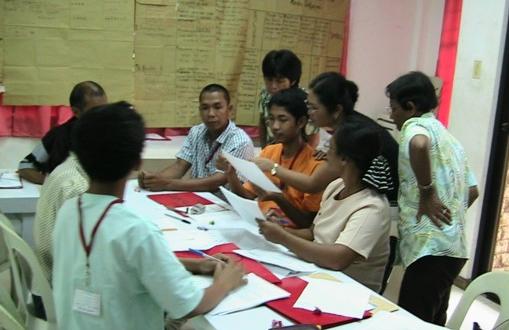
UP Prof. Evangeline C. Pasagui about their community health plan.
(Published in the Philippine Daily Inquirer, June 18, 2005, p. A20. This article was picked up by GMA Station for a TV feature story that was broadcast in the Reporter's Notebook program in the night of June 28, 2005. The title of the seven-minute segment was "Bihag sa Kahirapan" and was reported by Carlo Lorenzo.)
IN THE WORDS of Eastern Samar folk, "ga-ud" refers to floating garbage that drifted toward the sea from several large rivers in the province but which clog the mouths of their tributary creeks and streams.
Elsewhere in the Waray-speaking areas of Leyte-Samar, ga-ud refers to a piece of rope used to bind something to a fixed position or an obstacle to one's freedom of movement.
Both definitions apply to Barangay Bantayan in Oras town, Eastern Samar. Floating garbage often clogs the mouth of its waterway connecting to the Oras River and obstructs river traffic.
As a result, sampans often get stuck with thick volumes of ga-ud within view of the scenic Oras Bridge linking the poblacion to the south of the province. The engine-driven small boats without outriggers are the only passenger and cargo vehicles that ply to and from the village along a narrow 3-kilometer stream winding through nipa and mangrove swamps.
"Bantayan presented the worst plight among the barangays whose health committee members had attended our trainings," Prof. Mae Florence D. Nierras said. Nierras led a team of professors from the University of the Philippines' School of Health Sciences in Leyte that held eight community health planning trainings for more than 200 leaders from 26 barangays in four towns in Eastern Samar from February to April.
The trainings were funded by the Eastern Samar Program Unit of Plan Philippines, a nongovernment organization working with local partners to build child-friendly communities.
With a population of 140 households, Bantayan has only one Jetmatic pump as source of potable drinking water.
Electricity comes from solar energy. The technology was introduced sometime ago as part of Australian government assistance. But this amenity mainly serves the barangay proper and does not reach all households.
Three sampans service the barangay, but with only one daily round-trip to town and only during high tide because the stream is shallow and silted. Fare is P10 per passenger.
Action on "ga-ud"
"The other [means of] access to the barangay from the highway is by hiking through a footpath and improvised foot bridges across three kilometers of swamps and fields," said Amador Libanan, 24, a schoolteacher and one of very few locals who have completed college. He teaches Grades 1 and 2 in the barangay school.
Bantayan produces rice, root crops, abaca and bananas, which are transported to the town on sampans.
Samuel Libanan, 40, the barangay chair, owns one of the sampans. He lamented the frequent clogging of the waterway's mouth with ga-ud - banana trunks, leaf-stripped nipa stalks, branches and twigs of trees and bamboos, plastic bags and fibers - that often got entangled with the boat's propeller, causing its engine to conk out.
Libanan has occasionally organized pintakasi teams (communal labor) from his barangay to remove the ga-ud, for which he had solicited funds and food donations from the municipal council.
So far, he has not tapped higher-level officials to help address the ecological problem that further isolates his barangay. He said he did not know whom to approach.
A training facilitator sent a text message to Gov. Ben Evardone to ask for possible action. The governor replied that he would refer the matter to the Provincial Tourism and Environment Office.
Ga-ud are usually taken by the river water to the Pacific Ocean when the tide ebbs. But when the tide rises, some drift back and fill the mouth of Bantayan's waterway.
"Ga-ud also litter the beach of three zones of our barangay at ebb tide and have to be cleaned up regularly," said Helen Balagasay, 29, a civic leader in the equally affected Barangay Tawagan, just across the poblacion. She attended the training together with the Bantayan residents in April.
Problem priority
During the three-day training, the participants were taught not only to identify their community problems but also to prioritize them.
"The participants often listed only those problems that they perceived would get funding from agencies and top officials. These were not necessarily their urgent problems," said Prof. Elvira L. Prejula, one of the trainers.
"The priorities often altered after the listed problems were subjected to the criteria of urgency, seriousness and scope introduced during the workshops."
Bantayan's ga-ud problem went down to third priority after child malnutrition, which affects one-fifth of children aged not more than 5 years old, and the lack of potable water supply.
"I hope we will get outside support this time," said Laura Montallana, 42, the local day care worker who looks after 26 preschool children.
"In formulating action plans for the prioritized problems, we advised the participants to think about support systems, not only from the government but also from the community and from nongovernment sources," said Prof. Evangeline C. Pasagui, who lectured on the planning process.
"We encouraged them to choose courses of action that are most comfortable to them, based on their past experience," she added.
Participants from 18 of the 26 villages represented in the training mentioned child malnutrition among their top three problems.
Eleven villages highlighted poverty or lack of income among their priorities while nine mentioned lack of potable drinking supply. Eight lamented the lack of essential medicines for their residents, and seven worried about the lack of sanitary toilets.
The problems bind a combined population of some 15,000 to difficult circumstances in the province. These are compounded by such ecological concerns as floating garbage and coastal erosion.